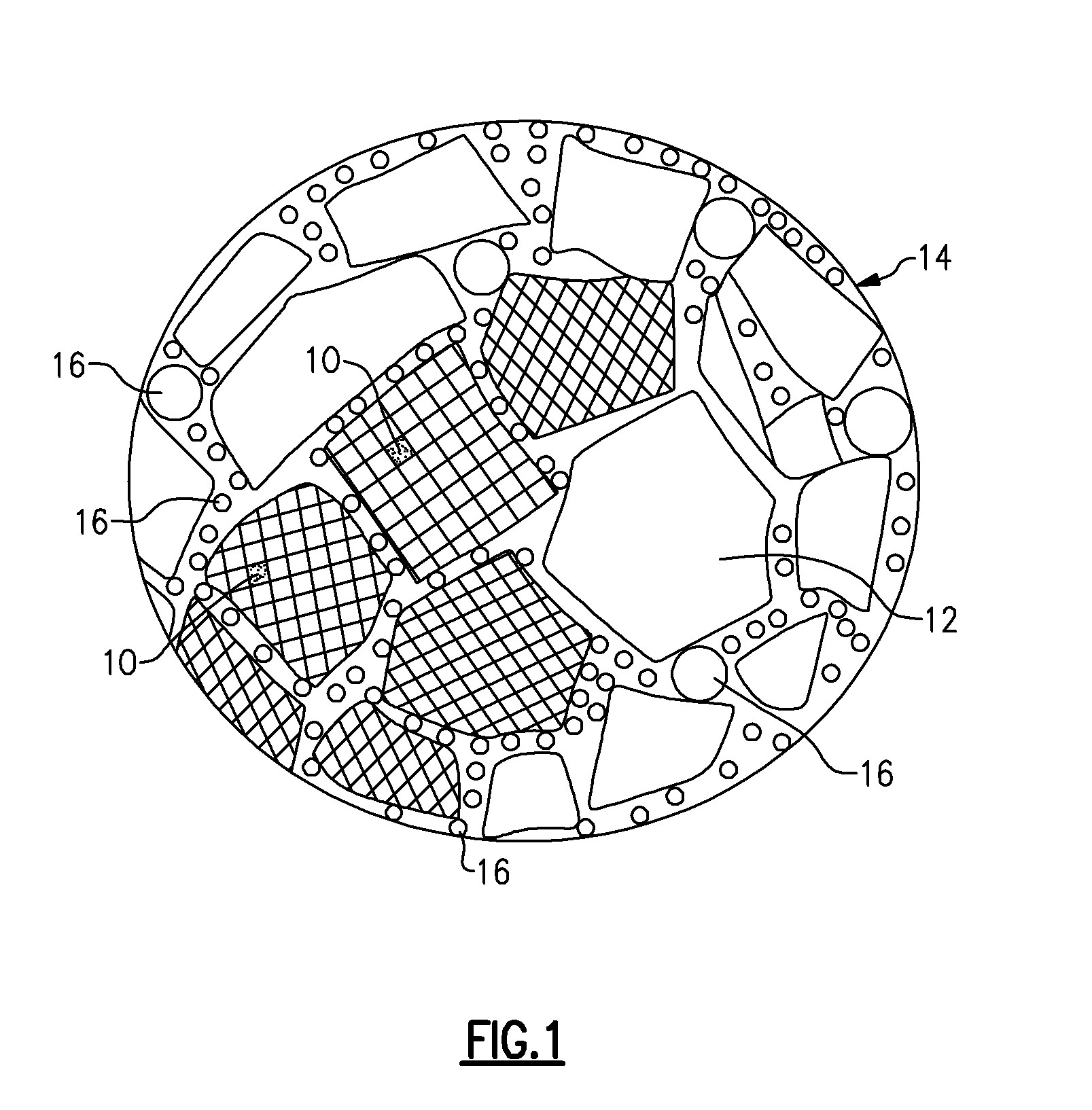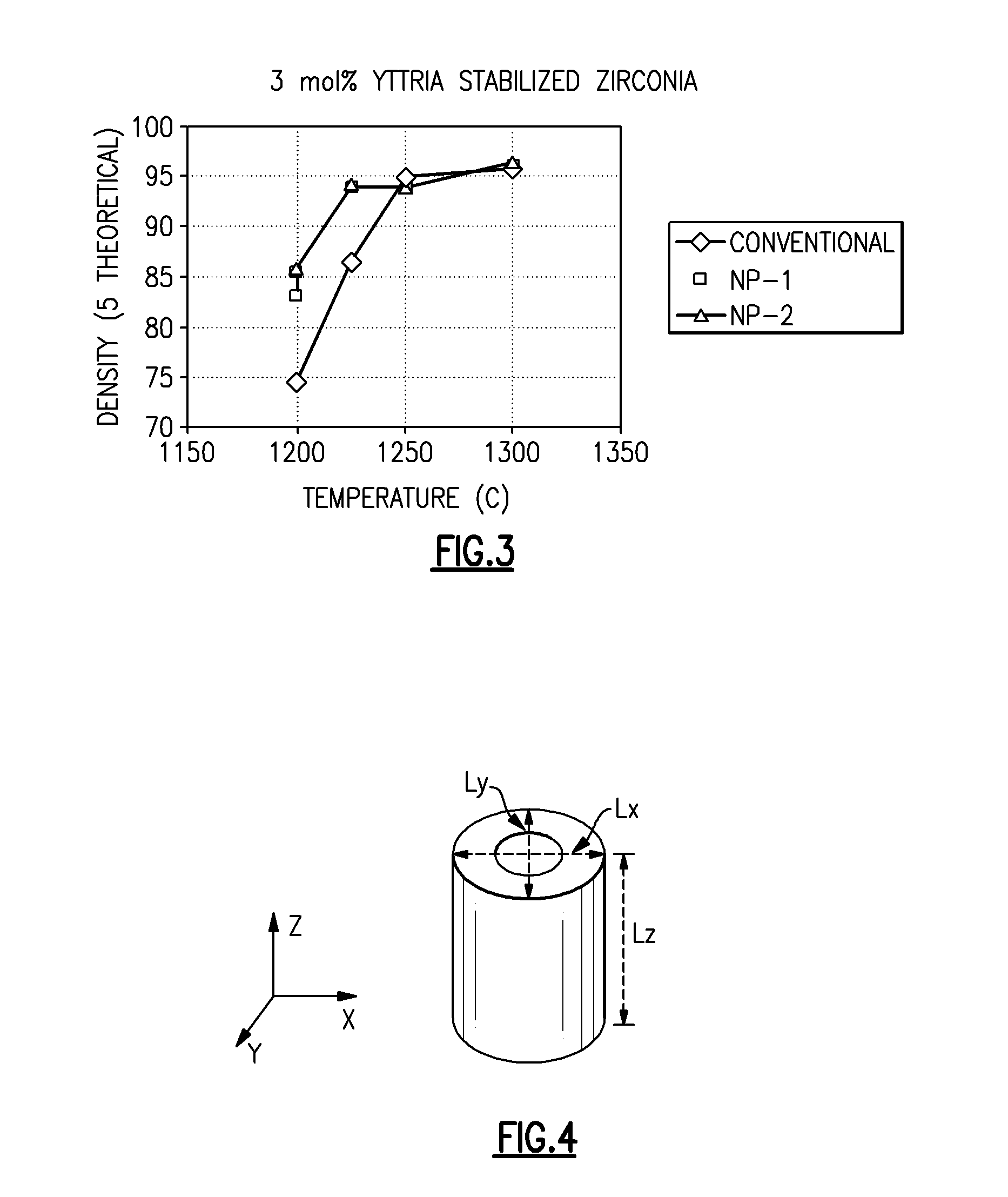Methods of Manufacturing Dental Restorations Using Nanocrystalline Materials
a nano-crystalline ceramic and nano-crystalline technology, applied in dental implants, inorganic chemistry, dentistry, etc., can solve the problems of substantial shrinkage, inability to popularize the technique, and inferiority of mechanical strength and chemical durability of corresponding crystalline ceramics, and achieve the effect of high density
- Summary
- Abstract
- Description
- Claims
- Application Information
AI Technical Summary
Benefits of technology
Problems solved by technology
Method used
Image
Examples
example 1
[0047]Commercially available TZ-3Y-E (which is a yttria-stabilized tetragonal zirconia powder) powder manufactured by TOSOH Corporation (Japan) with a crystallite size of about 30 nm can be sintered to full density at temperatures as low as 1350° C., which is 150° C. lower than the sintering temperature for conventional yttria-stabilized tetragonal zirconia polycrystals (YTZP) powder. Onset of sintering normally occurs at about 0.6 of the melting point (Tm) and the MPD effect described above results in a corresponding decrease in sintering temperature for nanopowder compared to conventional micron-size ceramic. If the size of the crystallites is reduced three times to about 10 nm, the anticipated reduction in the sintering temperature will be about 450° C., i.e., YTZP powder comprised of 10 nm nanoparticles is sinterable at about 1050° C. Thus, this powder may be sintered in a regular burn-out furnace with the maximum operating temperature of 1100° C. Example 2 below further illustr...
example 2
Low Temperature Sinterability of Nano-Zirconia Powders
[0048]Two commercially available nano-sized 3 mol % yttria stabilized zirconia powders were obtained from NanoProducts Corporation (Longmont, Colo. 80504, USA). The physical characteristics of these powders are listed in Table 3. Also listed are the properties of TZ-3YS-E powder available from Tosoh Corporation (Tokyo, Japan), a conventional so-called “easy sintering” 3 mol % yttria-stabilized tetragonal zirconia powder that was used for baseline comparison. The nano-powders were mixed with 5-10 wt. % PVA binder (Elvanol 50-42, Dupont) with a mortar and pestle, and then sieved through an 80 mesh screen resulting in free-flowing, pressable powder. The conventional zirconia powder was pressable to begin with, as it contained binder.
[0049]The powders were pressed into pellets using a double action die and then vacuum bagged and cold isostatically pressed (CIPed) at 400 MPa to remove any green density gradients. The resulting pellets...
example 3
[0051]Using the methods described in example 1, green cylindrical shaped bodies with dimensions of ˜12 mm diameter by ˜12 mm height were formed out of the NP-2 and conventional zirconia powders. A 5 mm diameter×8 mm deep hole was machined into the green bodies yielding a “cup” geometry. This geometry was chosen since it simulated a dental coping. After recording the orthogonal dimensions, L(x,y,z) where x and y refer to the diameters taken at a 90° rotation to each other and z refers to the height as illustrated in FIG. 4, the green bodies were burned out by heating at a rate of 2° C. / m to 700° C. and holding for 2 hours, and subsequently sintering at 1225° C. for 2 h with a heating and cooling rate of 4° C. / m. The dimensions of the sintered bodies were recorded and the sintering shrinkage was calculated. These results are shown in FIGS. 5 and 6. These data show that greater shrinkages were achieved for the nanosized zirconia powder versus the conventional zirconia, which agrees wit...
PUM
| Property | Measurement | Unit |
|---|---|---|
| Grain size | aaaaa | aaaaa |
| Grain size | aaaaa | aaaaa |
| Grain size | aaaaa | aaaaa |
Abstract
Description
Claims
Application Information
 Login to View More
Login to View More - R&D
- Intellectual Property
- Life Sciences
- Materials
- Tech Scout
- Unparalleled Data Quality
- Higher Quality Content
- 60% Fewer Hallucinations
Browse by: Latest US Patents, China's latest patents, Technical Efficacy Thesaurus, Application Domain, Technology Topic, Popular Technical Reports.
© 2025 PatSnap. All rights reserved.Legal|Privacy policy|Modern Slavery Act Transparency Statement|Sitemap|About US| Contact US: help@patsnap.com



